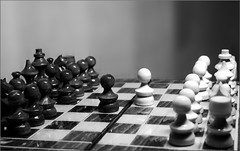This may be a little obvious, but the most basic source of tension, suspense and surprise is conflict. We all know it makes a good story, but it can also make a story great.
All techniques to create suspense and tension have conflict at their heart. Just check out my 37 ways to increase suspense and tension—most of them involve creating or highlighting conflict.
 Obviously, most of the external plot and internal conflict come from conflict—the obstacles that stand between our protagonist(s) and their goal. That will be the main source of the suspense that keeps the readers wanting to know more.
Obviously, most of the external plot and internal conflict come from conflict—the obstacles that stand between our protagonist(s) and their goal. That will be the main source of the suspense that keeps the readers wanting to know more.
However, on a smaller level, conflict within a scene establishes and heightens the tension. This is one reason why it’s so important to have a scene goal for the character—once the character wants something, it’s easy to bring in that conflict, to prevent them from getting that goal. A story where the character decides he wants chips, goes in the kitchen and gets chips . . . well, it really isn’t a story, is it?
Rather than being an element to create surprise, conflict is important in making a surprise matter. An unexpected event has a much bigger impact if that surprise creates conflict. Take Jane Eyre. (If you’ve never read it, SPOILER ALERT.) Jane and her employer, Mr. Rochester, fall in love. Imagine if the surprise revealed at their wedding is that the source of the spooky noises in the mansion was his crazy sister? “Oh, well, you have a questionable genes. I still do.” The end. But his crazy wife? That’s a real surprise—and a real conflict.
Conflict, on a macro level and a micro level, is not just the heart of a story—it’s the heart of suspense and tension, as well. It’s what makes the events—and especially surprises—of a story matter to us.
What do you think? How else can conflict create suspense, tension or surprise?
Photo credit: Cristian V.


If your protagonist wants something, have your antagonist want something that would destroy the protagonists chances of reaching his/her goal.
Do you get David Farland’s Daily Kick in the Pants emails? He wrote that he wasn’t so much convinced that there were genres to books, but more of books that work to invoke different emotional responses in us. Some are written to invoke thrills/terror, others mushy love, others a focus in world building, you get the idea. Well, I’m a thrill seeker and am absolutely addicted to suspense. I’ve gotten into the TV show Prison Break–that is a show with some serious suspense with the hero and his enemies’ desires constantly colliding.
That’s a great example of conflict. I actually had that same idea in the post, but I didn’t want to start going into specific techniques quite yet.
ETA: Actually, I also didn’t want to imply that’s the only way to create conflict, since there’s inner conflict (and I’d have to give a specific example of how to create that), inhuman forces, circumstance, etc. that can also create conflict.
Amazing that a lot of people don’t think it’s obvious. They just think that “conflict” is this abstract concept where their characters need to do something for some reason but they don’t really know why.
I definitely need to ratchet up my conflict so I’m always looking for ideas…looking forward to more posts!